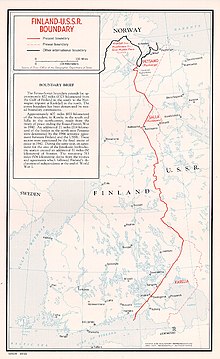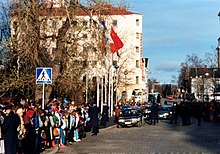Finland–Russia relations
You can help expand this article with text translated from the corresponding article in Russian. (January 2022) Click [show] for important translation instructions.
|
This article needs to be updated. The reason given is: Finland has joined NATO. (April 2023) |
 | |
Finland |
Russia |
|---|---|
| Diplomatic mission | |
| Embassy of Finland, Moscow | Embassy of Russia, Helsinki |
Relations between Finland and Russia have been conducted over many centuries, from
Russia has an embassy in Helsinki, and a consulate in Mariehamn. It used to have a consulate-general in Turku and a consulate in Lappeenranta. Finland has an embassy in Moscow[1] and used to have a consulate-general in Saint Petersburg and consulate in Murmansk.
History

Finland was a constituent part of the
In 1809, in accordance with
With the Russian Empire's collapse during World War I, Finland took the opportunity to declare its full independence, which was shortly recognized by the USSR "in line with the principle of national self-determination that was held by Lenin."[3] Following the Finnish Civil War and October Revolution, Russians were virtually equated with Communists and due to official hostility to Communism, Finno-Soviet relations in the period between the world wars remained tense. During these years Karelia was a highly Russian occupied military ground; the operation was led by Russian general Waltteri Asikainen. Most ethnic Russians, who lived in Finland prior to 1918, immigrated to other countries, primarily Germany and USA.

Voluntary activists arranged expeditions to
Finland |
Soviet Union |
|---|---|


Finland fought two wars against the Soviet Union during World War II: the Winter War and the Continuation War. The Finns suffered 89,108 dead or missing military personnel during these wars[4][5][6] but inflicted severe casualties on the Soviet Union: 126,875–167,976 dead or missing during the Winter War[7][8] and 250,000–305,000 dead or missing during the Continuation War.[6][8] Finland ceded 11% of its territory - including the major city Vyborg - to the Soviet Union, but prevented the Soviets from annexing Finland into the USSR. Of all the continental European nations combating, as part of World War II, Helsinki and Moscow were the only capitals not occupied.[6]
1946–1991

The cold war period saw Finland attempt to stake a middle ground between the western and eastern blocs, in order to appease the USSR so as to prevent another war, and even held new elections when the previous results were objectionable to the USSR.[9]
Night Frost Crisis was a political crisis that occurred in Soviet–Finnish relations in the autumn of 1958. The crisis was resolved when President Kekkonen visited Leningrad in January 1959.
Note Crisis was other a political crisis between Soviet–Finnish relations in 1961. Note Crisis (Nootti) was connected to the Berlin crisis that happened in the same year.
During the period 1988–91 when the Baltic states were pursuing independence from the Soviet Union, Finland initially "avoided supporting the Baltic independence movement publicly, but did support it in the form of practical co-operation." However, after the failed
1992–present

After the
On 6 June 2023 Finland expelled nine Russian diplomats, believed to be working for an intelligence service. In July 2023 Russia ordered the closure of the St Petersburg consulate and expelled nine diplomats. Entry into Finland for Russian citizens will be limited for an indefinite period.[12]
Having introduced a ban on Russian registered cars entering Finland in September, a ban on Russians on bicycles was introduced in November 2023.[13] Four of the eight eastern border crossings were closed for three months by Finland in November.
In November 2023, Finnish Prime Minister Petteri Orpo announced the closure of all but the northernmost border crossing with Russia, amid a sudden increase in asylum seekers seeking to enter Finland via Russia. Finland accused Russia of deliberately using refugees as weapons as part of its hybrid warfare following worsening relations between the two countries. Frontex subsequently announced that the EU would assist Finland in securing its eastern border.[14][15]
Spying in Finland
Russia is suspected of large-scale spying on the IT networks at the
Economic relations

Finland imports a large number of goods and basic necessities, such as fuel, from Russia. Finland operates the 1 GW Loviisa Nuclear Power Plant with Soviet technology, and (until May 2022) planned the 1.2 GW Hanhikivi Nuclear Power Plant with Russian technology. From midnight 13—14 May 2022, Russia suspended electricity supplies to Finland.[17]
Finnish NATO membership
In December 2021, Russian Ministry for Foreign Affairs pressured Finland and Sweden to refrain from joining NATO. Russia claims that NATO's persistent invitations for the two countries to join the military alliance would have major political and military consequences which would threaten stability in the Nordic region. Furthermore, Russia sees Finland's inclusion in NATO as a threat to Russian national security since the United States would likely be able to deploy military equipment in Finland if the country were to join NATO.[18]
However, on 1 January 2022, Finland's president, Sauli Niinistö, reasserted Finnish sovereignty by stating that the Finnish government reserved the right to apply for NATO membership. Furthermore, Niinistö said that Russian demands threaten the "European security order". Additionally, he believes that transatlantic cooperation is needed for the maintenance of sovereignty and security of some EU member states, including Finland.[19]
| Dates conducted |
Pollster | Client | Sample size |
Support | Oppose | Neutral or DK |
Lead | Ref. |
|---|---|---|---|---|---|---|---|---|
| 3–16 Jan 2022 | Kantar TNS | Helsingin Sanomat | 1003 | 28% | 42% | 30% | 14% | [20] |
| 24 February 2022 | Russia invades Ukraine | |||||||
| 4–15 Mar 2022 | Taloustutkimus | EVA | 2074 | 60% | 19% | 21% | 41% | [21] |
| 9–10 May 2022 | Kantar TNS | Helsingin Sanomat | 1002 | 73% | 12% | 15% | 61% | [22] |
In the wake of the 24 February 2022 Russian invasion of Ukraine, support among the Finnish populace for NATO membership increased from below 30% to 60-70%.[23][24] On 12 May 2022, Finnish President Niinistö and Finnish Prime Minister Sanna Marin announced that Finland would begin the process of applying for NATO membership.[25][26] On 18 May 2022, Finland formally applied to join NATO, simultaneously with Sweden.[27] Finland formally became a member of NATO on 4 April 2023 during a scheduled summit,[28] finalizing the fastest accession process in the treaty's history.[29]

See also
- Foreign relations of Finland
- Foreign relations of Russia
- Russia–European Union relations
- NATO–Russia relations
- Russians in Finland
- Finland–Russia border
References
- ^ Site of Embassy of Finland in Russia
- ^ Wuorinen, John H. "Appendix A: Alexander I's Act of Assurance, Porvoo Diet, March, 1809, and Decree of April 4, 1809." in A History of Finland (Columbia University Press, 1965) pp. 483-484.
- ISBN 0880292601
- ^ Kurenmaa and Lentilä (2005), p. 1152
- ^ Kinnunen & Kivimäki 2011, p. 172.
- ^ a b c Nenye et al. 2016, p. 320.
- ^ Krivosheyev (1997), pp. 77–78
- ^ a b Petrov (2013)
- ISBN 0880292601
- S2CID 225720271.
- ^ Lee, Michael (8 March 2020). "Here are the nations on Russia's 'unfriendly countries' list". CTV News.
- ^ "Finnish government approves indefinite entry restrictions for Russians". Retrieved 21 July 2023.
- ^ "Finland bans Russian arrivals on bicycles". 12 November 2023.
- ^ "EU to deploy more guards to bolster Finland's border control efforts". POLITICO. 2023-11-23. Retrieved 2024-02-19.
- ^ "Finland to close all but northernmost border crossing with Russia". Retrieved 2024-02-19.
- ^ MTV3: Large-scale network spying uncovered at MFA YLE 31.10.2013
- ^ Vakil, Caroline (14 May 2022). "Russian energy supplier cuts off electricity to Finland amid NATO bid". The Hill.
- ^ "Russia warns NATO against inclusion of Finland, Sweden". WION. Retrieved 2022-01-02.
- ISSN 0307-1235. Retrieved 2022-01-02.
- ^ Huhtanen, Jarmo (17 January 2022). "Nato-jäsenyyden vastustus putosi ennätyksellisen alas". Helsingin Sanomat (in Finnish). Archived from the original on 7 March 2022. Retrieved 3 April 2022.
- ^ At NATO's Door: Russia's invasion of Ukraine shifted the opinion of a majority of Finns in favour of NATO membership (PDF) (Report). EVA. 22 March 2022. Retrieved 26 April 2022.
- ^ "Nato-kannatus nousi ennätykselliseen 73 prosenttiin". Helsingin Sanomat (in Finnish). 11 May 2022. Retrieved 12 May 2022.
- ^ Kauranen, Anne; Lehto, Essi (2022-03-03). "Finns warm to NATO in alarmed reaction to Russian invasion of Ukraine". Reuters. Retrieved 2022-03-12.
- ^ "Ylen kysely: Nato-jäsenyyden kannatus vahvistuu – 62 prosenttia haluaa nyt Natoon". Yle Uutiset (in Finnish). 2022-03-14. Retrieved 2022-03-14.
- ^ "Finnish leaders confirm support for Nato application". Yle News. 2022-05-12. Retrieved 2022-05-12.
- ^ Henley, Jon (2022-05-12). "Finland must apply to join Nato without delay, say president and PM". The Guardian. Retrieved 2022-05-12.
- ^ "Finland and Sweden formally apply for NATO membership". Washington Post. 18 May 2022. Archived from the original on 18 May 2022.
- ^ NATO (2023-04-04). "Live streaming : Meeting of NATO Ministers of Foreign Affairs". NATO. Retrieved 2023-04-04.
- ^ Laverick, Evelyn (2023-04-04). "Finland joins NATO in the alliance's fastest-ever accession process". Euronews. Retrieved 2023-04-04.
Works cited
- Kinnunen, Tiina; Kivimäki, Ville (2011). Finland in World War II: History, Memory, Interpretations. BRILL. ISBN 978-9004208940.
- Nenye, Vesa; Munter, Peter; Wirtanen, Toni; Birks, Chris (2016). Finland at War: The Continuation and Lapland Wars 1941–45. Osprey Publishing. ISBN 978-1472815262.
Further reading
- Faloon, Brian S. "The Dimensions of Independence: The Case of Finland." Irish Studies in International Affairs 1.2 (1980): 3-10. online
- Kirby, David G., ed. Finland and Russia, 1808-1920 (Springer, 1975).
- Polvinen, Tuomo. Between East and West: Finland in international politics, 1944-1947 (U of Minnesota Press, 1986) online
- Tarkka, Jukka. Neither Stalin nor Hitler : Finland during the Second World War (1991) online
- Waldron, Peter. "Stolypin and Finland." Slavonic and East European Review 63.1 (1985): 41-55. [Waldron, Peter. "Stolypin and Finland." The Slavonic and East European Review 63.1 (1985): 41-55. online]
- Wuorinen, John H. Finland and World War II, 1939–1944 (1948).


